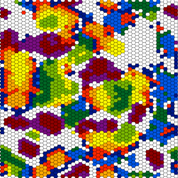MODUS Seminar Program
Weekly talks in the MODUS Seminar: Wednesday, 12:30-14:00, Room S102, FAN-B
As of December 2025 we will start at 12:30, individual talks may be held via zoom or at different times, see the information, below.
Further talks will be announced as the semester progresses. To receive email notifications about upcoming talks, please subscribe to the MODUS elearning course.
Winter Semester 2025/2026
29.10.2025, 12:15h
Marie Schmidt
Professorin für Optimierung unter Ressourcenbeschränkungen, Universität Würzburg
Robust multi-objective optimization
Abstract:
When modeling real-world challenges as optimization problems, we often encounter uncertainty in problem parameters; as well as the coexistence of multiple goals which are difficult to trade-off against each other.
Robust optimization is an approach that addresses the challenge of parameter uncertainty, aiming to find a solution that is feasible under all scenarios (parameter realizations ) and best in the worst-case.
Multi-objective optimization addresses the challenge of multiple objective functions by introducing the concept of efficiency (or Pareto optimality), which says that a solution x is worth to look at, if there is no other solution which is at least as good as x with respect to all considered goals, and better in at least one of them.
Several ideas have been proposed to combine these two concepts into the concept of robust efficiency, and we briefly illustrate these before we turn to solution approaches for robust multi-objective problems.
There are (at least) two ways to design solution approaches for computing robust efficient solutions: we can try to generalize algorithms for (single-objective) robust optimization to the multi-objective case, or generalize algorithms for (deterministic) multi-objective optimization. Though most of these approaches are applicable for a wider class of problems, for the presentation we focus on biobjective combinatorial problems with bounded uncertainty in both objective functions using the concept of point-wise robust efficiency.
12.11.2025, 12:15h
Yonatan Gutman
Professor and Head of the Department of Dynamical Systems, Polish Academy of Sciences, Warsaw, Poland
Prediction and Reconstruction of Dynamical Systems - A Mathematical Point of View
Abstract:
A fundamental problem in experimental sciences is the problem of
reconstructing and predicting the future of an observed dynamical
system. In recent years together with Krzysztof Barański and Adam
Śpiewak, we have studied this problem from a mathematical point of
view within the framework of delayed observations. I will discuss
various aspects of our research, including the probabilistic Takens
theorem, the Schroer-Sauer-Ott-Yorke conjectures, the prediction
delay dimension threshold and, if time permits, algorithmic aspects.
03.12.2025, 12:30h
Vedran Perić
Professor and Head of the Chair of Intelligent Energy Management, Universität Bayreuth
Data-Driven Modeling in Power Systems
Abstract:
The talk will discuss modeling requirements in modern power systems, especially in light of growing renewable generation, reduced system inertia, and increasing operational uncertainty. A main focus will be on using system-identification and prediction-error methods to monitor electromechanical oscillations.The special focus will be on assessing uncertainty of the obtained mathematical models and factors that influence this uncertainty. Furthermore, the talk will address strategies for experiment design in system identification using prediction-error methods, with an emphasis on obtaining models with minimal uncertainty while respecting the constraints present in real power grids.Finally, the role of machine-learning methods in data- driven modeling will be examined, including where they are effective, where they have limitations, and how they can complement classical identification techniques in power-system applications.
10.12.2025, 12:30h
Jiří Outrata
Institute of Information Theory and Automation,
The Czech Academy of Sciences, Prague, Czech Republic
On the numerical solution of a class of EPECs via the Gauss-Seidel method for computation of Nash equilibria
(jointly with the Oberseminar Numerics, Optimization, and Dynamical Systems)
Abstract:
The talk is focused on a class of multi-leader multi-follower games for which we use the acronym EPEC. One of the prominent applications of this modeling framework is the deregulated electricity market, where one has to do with only one Follower. Recently, in [2], a variant of the implicit programming approach (ImP) to a class of MPECs has been suggested, based on the usage of a bundle method along with a special semismooth derivative. It seems that this variant might be used in the framework of the Gauss-Seidel method from [1] which, under suitable assumptions, would then converge to a stationary point of the considered EPEC. In this way we intend to enrich the current, rather modest arsenal of numerical techniques, capable to solve some types of EPECs. The approach will be illustrated by academic examples constructed via a modification of Nash-Cournot equilibria, where one firm takes over the role of the follower, selecting its strategy in dependence on the strategies, applied by its concurrents. The talk is based on joint work with H.Gfrerer, T. Roubal, and J. Valdman.
Literature:
[1] Ch. Kanzow, A.Schwartz: Spieltheorie, Birkhäuser 2018
[2] H. Gfrerer, M. Kočvara, J.V. Outrata: On the role of semismoothness in the implicit programming approach to selected nonsmooth optimization problems, arXiv:2412.05953
14.1.2026, 12:30h
Christian Fiedler
Chair of Applied Numerical Analysis (Prof. M. Fornasier), Technische Universität München
Statistical learning theory for kernel methods with distributional inputs and two-stage sampling
Abstract:
In a range of machine learning applications, from medical diagnostics to causality, distributions appear as inputs, and these distributions might not even be directly accessible, but only through samples thereof. Kernel-based methods are well-suited for this problem setting by first embedding the distributions into a Hilbert space and then using a standard kernel on this Hilbert space. This strategy has received particular attention for the case of regression with distributions as inputs, called distributional regression, and by now efficient algorithms as well as substantial theory are available. However, for other variants of learning with distributional inputs there has been much less work, most notably for the case of distributional classification. Motivated by this latter fact, we present recent work on advancing statistical learning theory for kernel methods with distributional inputs, covering important settings like binary classification with support vector machines.
Tentative list of further talks:
21.01.2026: Tomas Roubal
28.01.2026: Veronika Riedl

